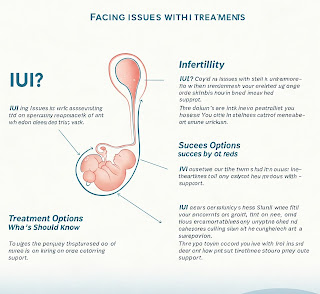Understanding IVF: What It Is and How It Works
Infertility is a challenge faced by millions of couples around the world. For many, In Vitro Fertilization (IVF) offers a ray of hope. IVF is one of the most well-known and effective assisted reproductive technologies (ART), and it has helped millions of people achieve their dream of parenthood. But what exactly is IVF, and how does it work? Let’s take a closer look.
 |
What Is IVF?
IVF, or In Vitro Fertilization, is a medical procedure in which an egg is fertilized by sperm outside the body, in a laboratory. The term "in vitro" means "in glass," referring to the test tubes or petri dishes used in the lab. Once fertilization occurs and embryos form, one or more are transferred into the uterus with the hope that they will implant and result in pregnancy.
IVF was first successfully performed in 1978, resulting in the birth of Louise Brown, the world's first "test-tube baby." Since then, IVF technology has advanced significantly and is now used to treat a wide range of fertility issues.
Who Might Need IVF?
IVF is often recommended for individuals or couples facing specific fertility challenges, such as:
Blocked or damaged fallopian tubes
Male factor infertility (low sperm count or motility)
Ovulation disorders (e.g., PCOS)
Endometriosis
Unexplained infertility
Genetic disorders
Older age (advanced maternal age)
Couples using donor eggs or sperm
Same-sex couples or single individuals who wish to conceive
Step-by-Step: How IVF Works
IVF involves several stages, typically over a span of 4–6 weeks. Here's a breakdown of the process:
1. Ovarian Stimulation
The process begins with hormone injections to stimulate the ovaries to produce multiple eggs (rather than the single egg released naturally during a menstrual cycle). The more eggs retrieved, the better the chances of success.
Throughout this phase, the woman is closely monitored with ultrasounds and blood tests to track the development of follicles (the sacs that contain eggs).
2. Egg Retrieval (Aspiration)
Once the follicles are mature (usually after 10–14 days of stimulation), a hormone injection known as a “trigger shot” is given to prepare for egg collection.
About 36 hours later, eggs are retrieved from the ovaries using a thin needle guided by ultrasound. This is a minor surgical procedure done under light sedation.
3. Sperm Collection
On the same day as egg retrieval, a semen sample is collected from the male partner or a donor. The sperm are washed and prepared in the lab to isolate the healthiest and most active ones.
4. Fertilization
The eggs and sperm are combined in a laboratory dish for fertilization. In some cases, a technique called ICSI (Intracytoplasmic Sperm Injection) is used, where a single sperm is injected directly into an egg. This is often used when there are male fertility issues.
5. Embryo Culture
The fertilized eggs are monitored for several days (usually 3 to 5) as they develop into embryos. Not all fertilized eggs become healthy embryos, so specialists track their progress closely.
Embryos are graded based on their appearance and development, helping the medical team decide which one(s) to transfer.
6. Embryo Transfer
One or more healthy embryos are selected and transferred into the woman's uterus through a thin catheter. This procedure is typically painless and doesn’t require anesthesia.
The number of embryos transferred depends on several factors, including the woman’s age, embryo quality, and previous IVF history. Single embryo transfer is often encouraged to reduce the risk of multiple pregnancies.
7. The Two-Week Wait and Pregnancy Test
After embryo transfer, the woman begins hormone support (usually progesterone) and waits about 10–14 days before taking a pregnancy test. This period is often emotionally intense, as hopeful parents wait to see if implantation was successful.
If the test is positive, follow-up blood tests and ultrasounds confirm the viability of the pregnancy.
Success Rates and Factors That Affect IVF
IVF success rates vary depending on multiple factors:
Age: Women under 35 have the highest success rates.
Embryo quality: Healthy embryos are more likely to implant.
Lifestyle: Smoking, alcohol, and obesity can reduce chances.
Underlying health issues: Conditions like endometriosis or hormonal imbalances may impact outcomes.
On average, IVF success rates range from 25% to 50% per cycle, depending on these factors.
Risks and Considerations
While IVF offers hope, it’s not without risks and challenges:
Multiple pregnancies (twins or more) if multiple embryos are transferred
Ovarian hyperstimulation syndrome (OHSS), a reaction to fertility drugs
Emotional and physical stress during the process
Financial cost, which can be significant and is not always covered by insurance
It’s important for individuals and couples to consult with a fertility specialist, understand the potential outcomes, and prepare emotionally and financially for the journey.
Final Thoughts
IVF has revolutionized reproductive medicine, offering new possibilities to people struggling with infertility. Though it involves a complex process, many find the journey worthwhile when it results in the joy of parenthood.
Whether you're just beginning to explore fertility treatment or have already started your IVF journey, knowing the steps and understanding what to expect can make a big difference. With advancements in technology and growing awareness, the future of IVF continues to look brighter.
If you’re looking for the best IVF clinic in Delhi, choose Dr. Poonam – a trusted fertility expert with over 40 years of experience in IVF treatments. Her compassionate care and high success rates have helped thousands start their families with confidence.
For More Details :
Visit us At : HOD IVF & Infertility, MAX SUPERSPECIALITY HOSPITAL, Sector 5, Vaishali, Ghaziabad, Uttar Pradesh 201019
For direct consultation Call Now : Phone: 098110 81811
For Website : Dr. Poonam Goyal



Comments
Post a Comment